If you’ve ever found yourself feeling like Christmas cooking is a lot of work, spare a thought for our medieval ancestors. They had an entire twelve days of celebrations to cater for, almost all marked with their own revelry, pageantry and, of course, food to be prepared.
It’s not surprising they needed twelve days to let off steam. Today, we may get into the Christmas spirit with extra miniature treats throughout December. But once, Advent marked a period of semi-fasting. The Twelve Days of Christmas were an opportunity to indulge after three or four weeks of a ‘restricted diet’. These weeks must have felt very bleak indeed for the already-malnourished poor.
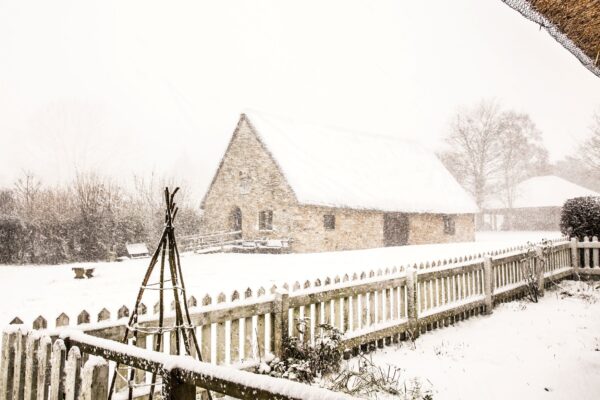
The Medieval Manor House in Snow, by Angela Waites Photography
Once the celebrations ended, the work would begin. Very soon there would be a return to toil, with ploughing due to last until March. It would be physically exhausting! Unsurprisingly, as the Twelve Days progressed, the festivities reached a roistering climax, often on the glorious Twelfth Night. In this area, it was actually on the following Monday, known as Plough Monday, that celebrations peaked, marked by sword dancing on the North York Moors.
A perplexing history
These celebrations have been much debated by historians and folklorists. By the beginning of the twentieth century, a connection was suggested with ancient fertility rites. By the 1960s, some folklorists were, probably incorrectly, describing the sword dance from the region as rooted within a Neolithic rite to awaken the earth from its winter sleep. Indeed, the noise of the dancers would have been enough to wake most sleepers! It’s easy to see why they have been interpreted this way. These dances took place in rural areas where life was at the mercy of the whims of the harvest.
However, most historians have now discounted this theory of Pagan origins, now believing the dances to have originated during the medieval period. In this country they have been traced as far back as 1777, when antiquary John Brand recorded seeing the ‘lock’ formation in Tyneside, and to the fourteenth century in the Netherlands.
An elaborate dance routine
The Goathland Plough Stots are a rare surviving group from the North York Moors. They were revived after a forty-year break by schoolmaster Frank W. Dowson in 1922, with their five unique dance routines dating to at least to the early-nineteenth century.
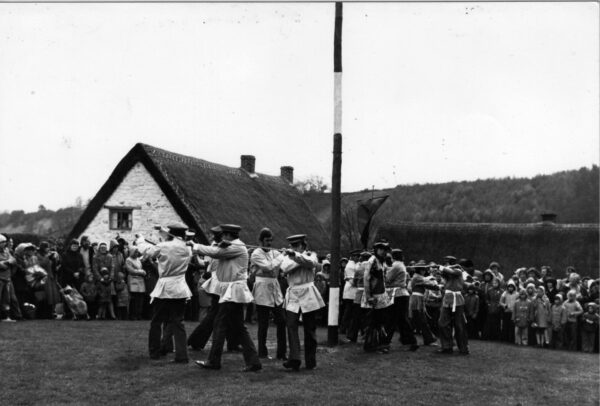
The Goathland Plough Stots perform at Ryedale Folk Museum, by Geoffrey Willey.
Similar dances were known in other parts of Yorkshire, as well as Cleveland and Northumberland.
As part of the pageantry, the dancers wore elaborate dress or embellished existing clothes with ribbons. Photos in Ryedale Folk Museum’s collection capture them during the middle of the twentieth century, including performing at our museum.
Their dances begin with ceremonial words, either sung or shouted. There follows a complex routine marked by spectacular sword clashing, before the impressive ending when the intricately-locked swords are raised together.
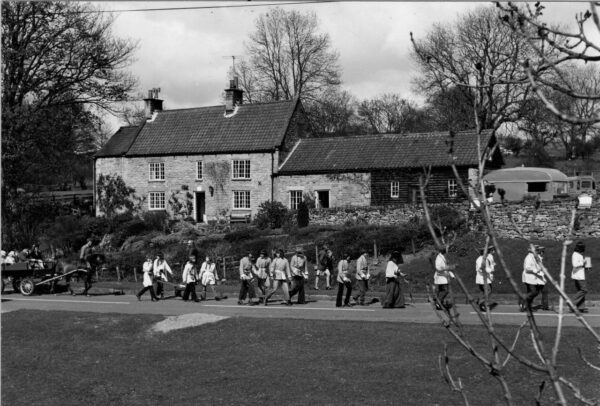
Processing with the Plough by Geoffrey Willey
The Goathland troupe also dragged a plough, giving rise to their name, stots being another word for bullock. This reference reinforces the physicality of their efforts and reminds us of the animals normally used for draught purposes with the plough.
The real purpose
It is difficult to pinpoint the exact arrival of the dance. However, most likely, the Plough Stots’ rise in popularity was a result of the financial exchange that took place. Money was collected in ‘payment’ for the highly-entertaining, celebratory spectacle, part of an acceptable system of begging. It is a reminder that for the poor the season was a time for celebration, but one they could not always afford.
Nowadays, the Museum is delighted to welcome the Goathland Plough Stots and other historic dancers to our Manor House for Christmas performances.
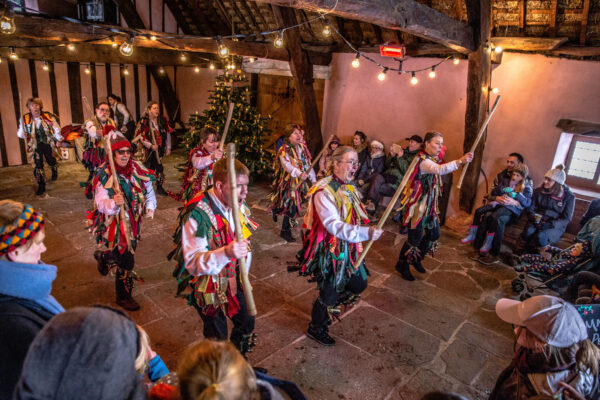
Historic dancers from ‘The Minster Strays’ perform at the Museum, by Angela Waites
